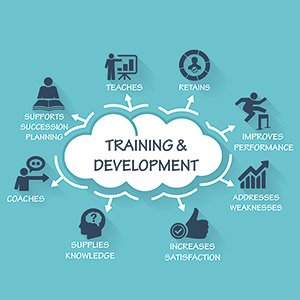In today’s dynamic and competitive business environment, the continuous growth and development of employees is not merely a luxury but a strategic imperative. Training and development programs have become indispensable tools for organizations aiming to boost productivity, enhance employee engagement, and stay ahead in a rapidly evolving marketplace. In this blog post, we’ll explore the significance of training and development in the modern workplace and the myriad ways it contributes to individual and organizational success.
Understanding Training and Development

- Training: Training is the process of imparting specific skills, knowledge, and competencies to employees, often with a focus on immediate job-related tasks. It can be conducted through workshops, seminars, on-the-job training, e-learning modules, and more.
- Development: Development, on the other hand, has a broader scope. It involves enhancing an employee’s overall abilities and potential, focusing on their long-term career growth and alignment with organizational objectives. Development may include mentorship, leadership programs, and self-paced learning.
The Significance of Training and Development
- Skills Enhancement: T&D equips employees with the knowledge and skills they need to excel in their current roles. It bridges the gap between existing competencies and the evolving requirements of the job.
- Increased Productivity: Well-trained employees are more efficient and productive. They make fewer errors, require less supervision, and can handle tasks with greater confidence.
- Employee Engagement: Training and development initiatives signal an organization’s commitment to its employees’ growth. Engaged employees tend to be more loyal, committed, and motivated.
- Talent Attraction and Retention: Companies offering comprehensive T&D programs are more attractive to prospective employees. They also tend to retain their existing talent, reducing turnover.
- Adaptation to Change: In a rapidly changing business landscape, employee development ensures that your workforce is adaptable and prepared to embrace new technologies and processes.
Key Elements of Effective Training and Development
- Customization: Tailoring T&D programs to meet the specific needs of employees and the organization is critical for success.
- Accessibility: Training should be easily accessible and available through various formats to accommodate diverse learning styles and schedules.
- Feedback and Assessment: Continuous feedback and assessment help gauge the effectiveness of T&D initiatives and identify areas for improvement.
- Leadership Involvement: Senior leadership should actively support and participate in training and development to set the tone for the organization.
- Integration with Business Goals: T&D should align with the company’s strategic objectives, ensuring that the skills being developed contribute to organizational success.
Benefits of Employee Development
- Improved Performance: Employees who receive continuous development are better equipped to perform their jobs, leading to enhanced organizational performance.
- Innovation: Well-trained and developed employees often bring fresh ideas and innovative solutions to the table, helping the company stay competitive.
- Succession Planning: Development programs can identify high-potential employees and prepare them for future leadership roles.
- Employee Satisfaction: When employees see that their employer invests in their growth and development, they are more likely to be satisfied in their roles and committed to the organization.
“Training and development are the cornerstones of progress in any organization. They empower individuals to reach their full potential and equip the workforce with the skills needed to drive success. A commitment to ongoing learning not only enhances employee satisfaction but also ensures the company remains competitive and adaptable in today’s rapidly evolving business landscape.”